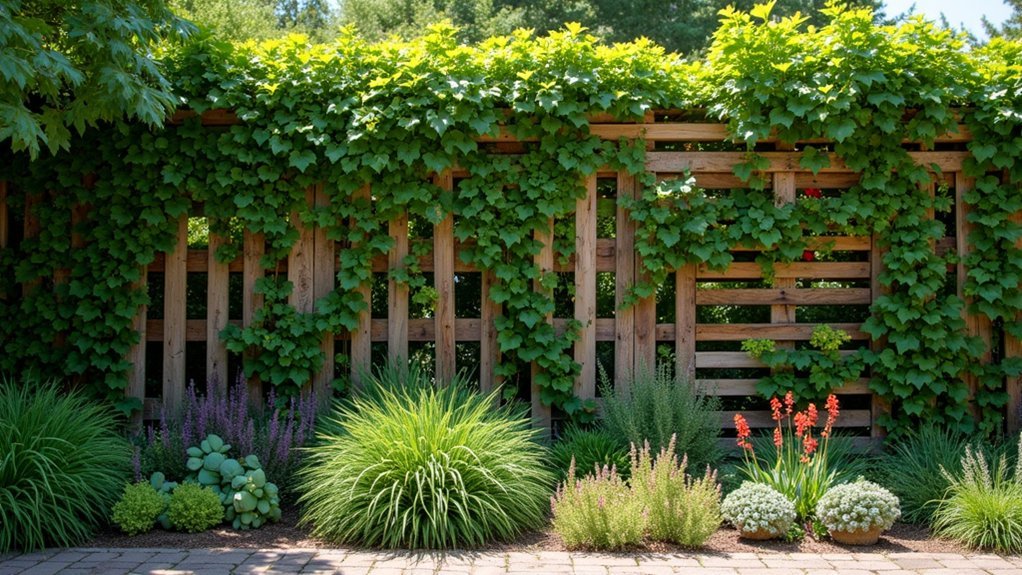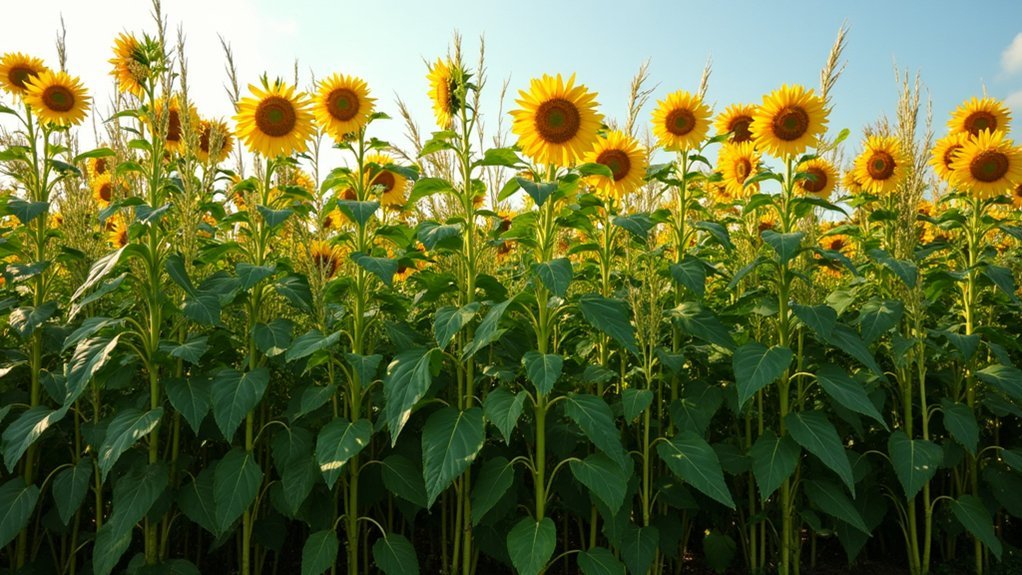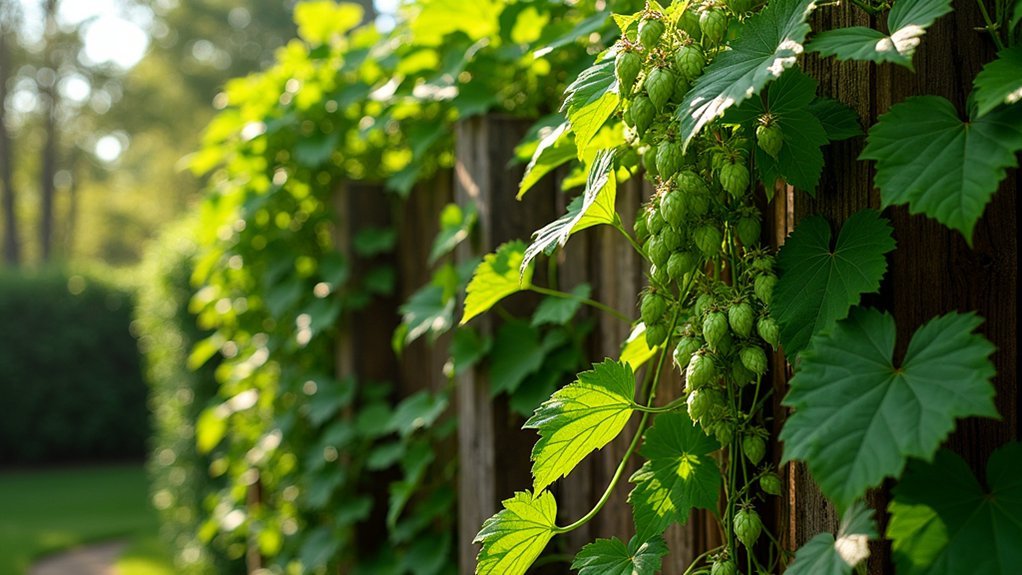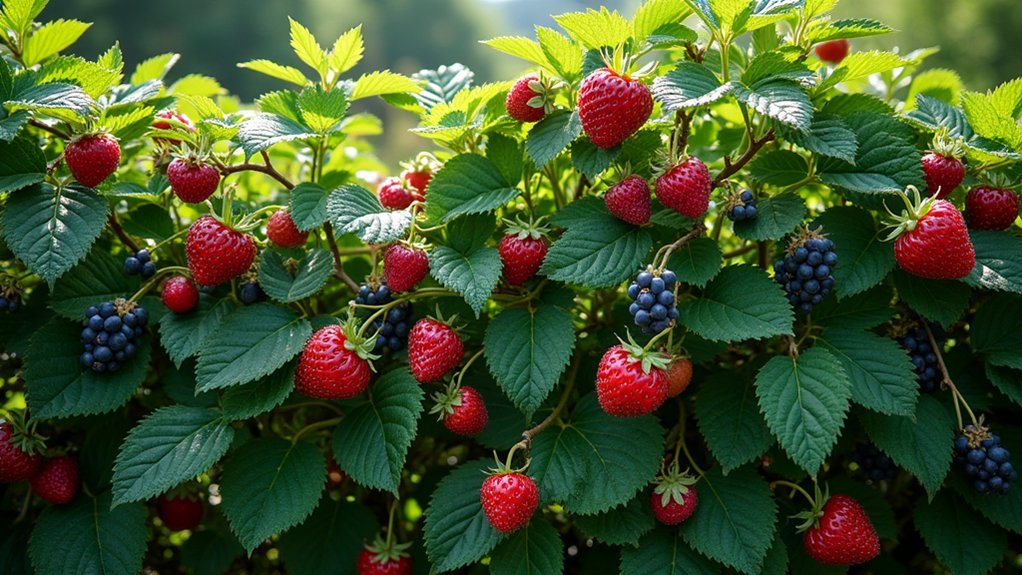Looking for unique privacy solutions? Try willow wattle fencing, seasonal sunflower barriers, dramatic pampas grass, climbing hops vines, or flowering hemp varieties. You’ll also find success with erosion-controlling vetiver grass, edible berry bushes, fragrant lavender hedgerows, fast-growing bamboo, or colorful azaleas. These living alternatives offer environmental benefits while creating beautiful, functional boundaries that traditional fencing can’t match. Discover how these natural options can transform your outdoor space below.
10 Unexpected Living Fence Materials For Privacy

When you think of living fences, the usual suspects like yews and privet hedges probably come to mind.
However, several unconventional options can provide privacy while adding unique character to your landscape.
Consider bamboo, which establishes quickly due to its rapid growth rate. Its tall, dense stalks create natural screens in just one season.
Bamboo transforms landscapes overnight, its vigorous shoots creating instant privacy where ordinary fences would take years.
Flowering azaleas offer privacy with the bonus of seasonal color bursts, unlike traditional evergreens.
You might also explore combination approaches, incorporating lattice or trellises with climbing plants. These structures provide immediate visual barriers while plants establish themselves.
For those with limited space, boxwood can be meticulously shaped into formal, compact barriers.
Blueberry bushes serve as productive privacy screens, reaching 8 feet tall while providing edible fruits throughout the growing season.
Whatever you choose, make certain it suits your climate and available space.
Though initial costs may exceed traditional fencing, you’ll gain long-term environmental and aesthetic benefits.
Willow Wattle: Ancient Technique for Modern Privacy
Among the unconventional privacy options, willow wattle fencing stands out as perhaps the most historically rich choice. This traditional weaving technique transforms flexible willow branches into sturdy, attractive barriers that blend seamlessly with natural landscapes.
You’ll need flexible willow branches, sturdy wooden stakes, and basic tools like secateurs and a sledgehammer to get started. Drive posts at regular intervals, then weave branches in a crisscross pattern between them, filling gaps with thinner branches for density. Wattle fencing has been utilized in human settlements for over 6000 years, revealing its time-tested effectiveness.
What makes willow wattle particularly appealing is its eco-friendly nature and low cost, especially if you source materials locally. It’s surprisingly adaptable to various terrains and provides excellent visual screening.
With occasional maintenance, your living fence will continue to enhance your garden’s privacy while supporting local wildlife.
Sunflower and Corn Seasonal Barriers

A surprising yet effective approach to privacy fencing comes from unlikely candidates in your vegetable garden: sunflowers and corn. These towering plants create natural screens that last from late spring through autumn, combining beauty with function.
For maximum screening effect, choose varieties like “Kong” or “Russian Giant” sunflowers that reach 10-12 feet tall, or plant corn in dense rows. Early planting guarantees ideal height and density. Starting sunflowers in small pots can protect young plants from environmental threats.
| Plant Type | Height | Special Features |
|---|---|---|
| Kong Sunflowers | Up to 12 ft | Dense privacy barrier, colorful |
| Russian Giant | 10-12 ft | Rapid growth, sturdy stems |
| Corn | 8-10 ft | Edible harvest, standing stalks last into winter |
You’ll need to replant annually, but you’ll enjoy environmental benefits like increased biodiversity and aesthetically pleasing screens that allow light and airflow.
Pampas Grass: Dramatic Height With Minimal Care
Pampas grass stands as a dramatic solution for homeowners seeking instant privacy with minimal maintenance requirements. This architectural powerhouse reaches impressive heights of 8-12 feet with a spread of 4-6 feet, creating an effective visual barrier up to second-story windows.
You’ll appreciate its rapid establishment, typically reaching near-mature size within just two growing seasons. The plant thrives in USDA zones 6-11, adapting to full sun or partial shade in well-draining soils.
Once established, it requires minimal water and care—simply cut back in late winter.
Beyond privacy, pampas grass offers additional benefits: its dense foliage dampens neighborhood noise, its billowing structure breaks wind patterns, and its feathery silver-white plumes provide year-round visual interest. Its beachy flair makes it an attractive addition to any landscape design.
For contained growth, seek sterile cultivars that won’t self-seed throughout your landscape.
Hops Vines: Brewing Privacy in Your Backyard

Climbing vigorously skyward at a rate that can astound even experienced gardeners, hops vines offer a dynamic privacy solution with an added bonus for home brewers.
These ambitious climbers can reach heights of 14-20 feet, creating effective natural screens when trained along fences or trellises. While they provide excellent coverage during summer, remember that hops only offer seasonal privacy as they die back in the fall.
You’ll need to commit to daily training initially, guiding these enthusiastic growers along your chosen support structure. Plant rhizomes at least 3 feet apart in well-drained soil and full sun. Their rapid growth requires regular pruning to maintain desired shape.
Both male and female plants work wonderfully for ornamental purposes, delivering unique scents and distinctive beauty throughout the seasons.
Beyond their privacy benefits, you’ll appreciate their adaptability to various structures and their potential for brewing use—truly a multifunctional addition to your landscape.
Cactus Fencing: Desert-Inspired Boundary Solutions
For homeowners seeking privacy solutions that thrive in arid conditions, cactus fencing offers an impressive combination of natural security and visual appeal.
These resilient plants require minimal water while their sharp spines serve as excellent deterrents against intruders.
Cacti thrive with little water yet offer formidable protection through nature’s own barbed security system.
When installing, space columnar varieties 12-36 inches apart, ensuring root balls reach 12-24 inches deep in well-draining soil. Always wear protective gear during planting.
Though slow-growing at just 1-3 inches annually, mature cacti create dense visual barriers that maintain year-round privacy in frost-free zones. Unlike traditional gate systems, cacti require no automated mechanisms for operation.
Establish a 3-foot buffer zone around walkways and consider warning signage for liability protection.
Beyond privacy, cacti support native pollinators, stabilize soil, and create microclimates for understory plants. Their fire-resistant properties and carbon sequestration capabilities make them environmentally beneficial boundary options.
Flowering Cannabis: Legal Hemp Varieties for Screening

Legal hemp varieties offer homeowners a unique privacy solution that combines rapid growth with environmental benefits. To stay compliant, choose varieties containing less than 0.3% Total THC and verify testing at DEA-registered labs before harvest. Getting a Certificate of Analysis is essential to ensure your privacy hedge remains within legal compliance.
Select varieties based on your specific needs:
| Variety Type | Privacy Benefits | Growing Considerations |
|---|---|---|
| Industrial Hemp | Robust, tall growth | Needs full sun, well-drained soil |
| Auto-flowering | Quick results, compact | Ideal for small spaces |
| High CBD | Market value, effective screen | Must maintain legal THC levels |
| Dwarf Hemp | Manageable in domestic gardens | Easier maintenance, less pruning |
Hemp privacy screens require regular watering despite being drought-tolerant. Their dense foliage creates effective barriers while improving soil structure and absorbing carbon dioxide. As a bonus, after serving as privacy screens, these plants can be harvested for sustainable products.
Vetiver Grass: Erosion Control With Privacy Benefits
If you’re battling erosion on slopes or property edges, vetiver grass offers a dual-purpose solution with its extensive root system that penetrates deep into soil while creating an attractive privacy screen above ground.
You’ll appreciate how this hardy grass forms a drought-resistant living barrier that withstands harsh conditions while effectively trapping sediment and slowing water runoff during storms.
The dense clumping habit creates a natural privacy fence that simultaneously stabilizes vulnerable areas on your property, making it ideal for terraced landscapes and steep terrain. Growing to heights of 5-7 feet, vetiver’s impressive vertical growth establishes a fire resistant hedge when properly maintained and irrigated.
Erosion Prevention Tactics
When seeking both privacy and erosion control, vetiver grass stands out as a remarkable solution with its extensive root system that can penetrate up to 10 feet deep.
This versatile grass thrives in virtually any soil condition, regardless of fertility, pH, or salinity.
You’ll reduce soil loss by up to 90% and decrease rainfall runoff by 70% when planting vetiver hedges.
These living barriers slow water flow, trap sediments, and capture valuable nutrients that would otherwise wash away.
They’re particularly effective on steep slopes and floodplains.
Vetiver grass has been nicknamed wonder grass for its exceptional ability to stabilize and rehabilitate highly erodible soils like acid sulfate soils and mining overburden.
As a low-tech, cost-effective alternative to conventional erosion control methods, vetiver requires minimal maintenance while delivering maximum results.
Its adaptability makes it ideal for agricultural protection, land rehabilitation, and preserving endangered ecosystems like coral reefs threatened by soil runoff.
Drought-Resistant Barrier Option
Vetiver grass’s exceptional drought resistance makes it a standout choice for homeowners seeking privacy solutions in water-scarce regions. Its deep roots extend 3-4 meters, creating stable barriers that withstand extreme conditions while requiring minimal water once established.
You’ll appreciate vetiver’s impressive functionality beyond privacy screening:
- Creates dense, year-round visual barriers with rapid vertical growth of 1-2 meters
- Reduces wind speed by 20-50% and dampens noise through its thick foliage structure
- Stabilizes slopes up to 45° while preventing soil erosion
Unlike traditional fencing, vetiver’s cost remains 3-5 times lower than engineered alternatives. You won’t need specialized tools for planting, and its long lifespan guarantees decades of privacy with just 1-2 annual trims for maintenance. Farmers report significant improvements in soil quality, transforming previously unfit land into fertile ground for additional plantings around your privacy barrier.
Mixed Berry Bushes: Edible Boundaries With Purpose

Privacy fences transform dramatically when designed with mixed berry bushes, creating boundaries that serve multiple purposes beyond mere screening.
You’ll enjoy visual diversity through varying colors, textures, and seasonal changes, especially with evergreen varieties like currants that maintain foliage year-round.
These living barriers offer practical benefits too—blueberries and elderberries can create tall privacy screens, while thornless blackberries provide maintenance-friendly options.
Most varieties require full sun to partial shade and prefer acidic to neutral soil conditions.
For maximum impact, combine different berry types to establish a layered ecosystem.
Some varieties like raspberry bushes can grow up to 6-8 feet tall, making them excellent choices for natural privacy screens.
Pair taller elderberries with mid-sized blueberries and edge with strawberry groundcover.
You’ll create not just a privacy barrier but a sustainable, edible boundary that attracts wildlife and enhances your landscape’s biodiversity.
Lavender Hedgerows: Fragrant Perimeter Protection
Lavender hedgerows offer your garden boundary a stunning purple aesthetic that persists even beyond the blooming season.
You’ll appreciate how these aromatic perimeters naturally repel unwanted pests while creating a fragrant barrier around your outdoor space.
Their drought-resistant nature makes them an excellent low-maintenance privacy screen option for regions with water restrictions or dry climates. For optimal results, space plants 18 to 24 inches apart to ensure proper air circulation while maintaining a dense, continuous privacy barrier.
Year-Round Purple Beauty
When seeking a fragrant yet functional perimeter solution, few plants rival the year-round beauty of lavender hedgerows. Standing 2-4 feet tall, these purple beauties create moderate privacy boundaries while transforming your garden into a sensory sanctuary.
Their vibrant blooms and calming scent enhance your outdoor space’s aesthetic appeal beyond what conventional fencing can offer. Lavender hedges support local ecosystems by providing nectar and pollen for beneficial insects throughout their blooming season.
For best results with your lavender hedge, remember:
- Choose varieties like Munstead or Provence based on your desired height and color intensity
- Plant in full sun with well-draining soil to prevent root rot
- Maintain with annual pruning to keep plants bushy and prevent woody stems
You’ll enjoy not just privacy but also environmental benefits as your hedge attracts pollinators and repels certain pests while creating habitat for small wildlife.
Pest-Repellent Border Solution
Beyond their stunning purple blooms, lavender hedgerows offer remarkable pest-repellent qualities that conventional fencing simply can’t match. The strong fragrance naturally deters aphids, mosquitoes, and moths while creating a barrier against deer and rodents.
You’ll find English and French varieties particularly effective for pest control, especially when planted with proper spacing to enhance air circulation. Combine different lavender types to maximize repellent capabilities while attracting beneficial pollinators like bees and butterflies.
This sustainable solution requires minimal maintenance—thriving in well-drained soil with full sun exposure. Unlike chemical alternatives, lavender supports your garden’s biodiversity while providing natural protection. Maintaining proper spacing helps prevent the spread of Alfalfa Mosaic Disease by reducing contact between plants.
Consider incorporating these fragrant perimeter plants alongside other pest-repelling companions for an extensive, eco-friendly defense system that looks beautiful year-round.
Drought-Tolerant Privacy Screen
Creating a drought-tolerant privacy screen with lavender offers three significant advantages over traditional fencing options.
This fragrant perimeter solution requires minimal watering once established, making it perfect for water-conscious landscaping while attracting beneficial pollinators to your garden.
Though lavender typically grows only 2-4 feet tall, limiting its privacy capabilities, it compensates with:
- Aromatic beauty that transforms garden edges into tranquil, fragrant retreats
- Sustainable, low-maintenance design requiring only annual pruning to maintain shape
- Vibrant seasonal blooms that enhance your yard’s aesthetic appeal
For ideal growth, plant lavender in well-drained soil with full sun exposure. Consider adding sand or gravel to improve drainage if your soil tends to retain water.
If you’re in a humid or extremely cold climate, you’ll need to take into account alternative options, as lavender thrives best in drier, moderate conditions.
Frequently Asked Questions
Are Living Fences Legal in Hoa-Controlled Neighborhoods?
Living fences are typically legal in HOA neighborhoods, but you’ll need to check your specific CC&Rs and get approval first. HOAs can regulate their appearance, height, and plant selection to maintain community standards.
How Do Living Fences Impact Property Boundaries and Potential Disputes?
Living fences can blur your property lines as they grow, potentially leading to disputes. You’ll need clear agreements with neighbors about maintenance and boundaries. Consider getting regular surveys to document the precise boundary location.
What’s the Maintenance Cost Comparison Between Living and Traditional Fences?
You’ll spend $100-500 annually on living fence pruning compared to $50-300 for traditional fences. While living fences require regular care, traditional options like vinyl cost less to maintain but have higher replacement expenses.
Can Living Fences Provide Security Against Intruders?
Living fences provide some security, but they’re not foolproof. You’ll get better protection by combining them with motion lights or cameras. They create visual barriers but have gaps that determined intruders could exploit.
How Do Living Fences Affect Wildlife and Local Ecosystems?
Living fences benefit wildlife by creating habitats, supporting biodiversity, and forming migration corridors. You’ll notice they’re less disruptive than traditional fencing, preventing erosion, sequestering carbon, and maintaining ecosystem balance in your local area.
In Summary
You’ve now discovered some unusual living fence options that go beyond standard hedges. Whether you’re drawn to the rustic appeal of willow wattle or the edible benefits of berry bushes, these alternatives offer both privacy and purpose. Don’t be afraid to mix materials for year-round coverage. With creativity and patience, you’ll transform your property boundaries into living, breathing assets that enhance your outdoor space’s beauty and functionality.





Leave a Reply